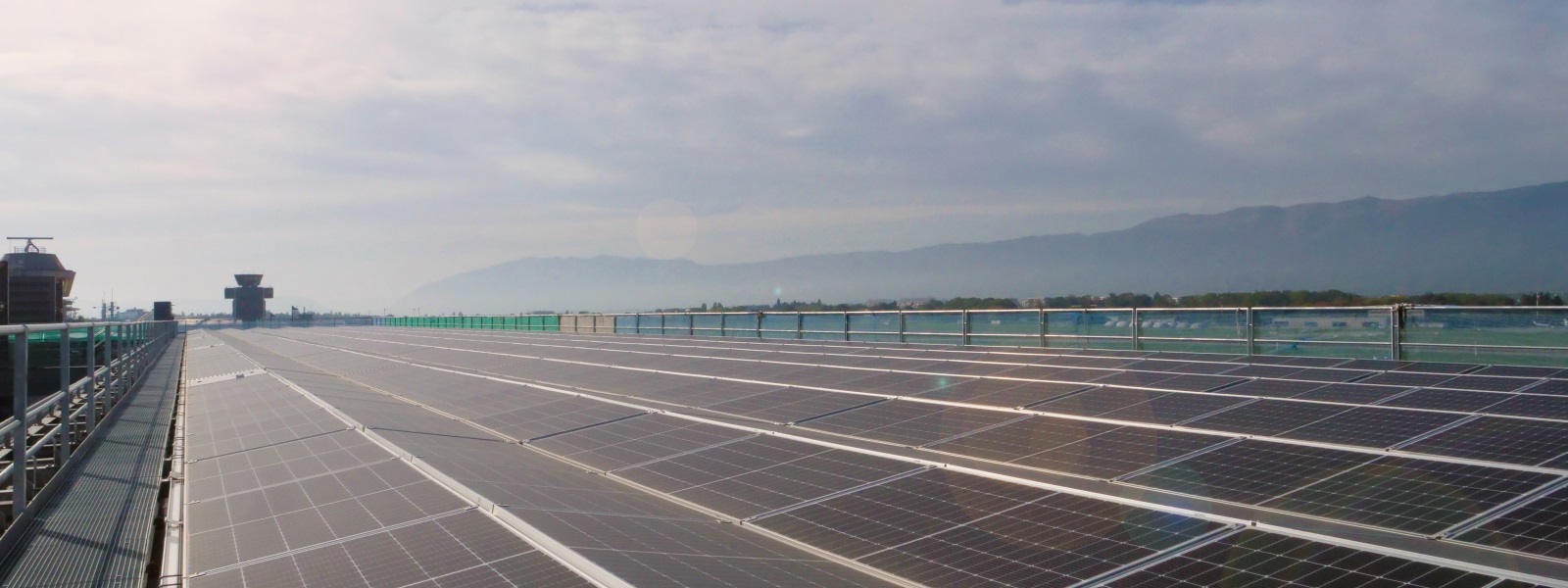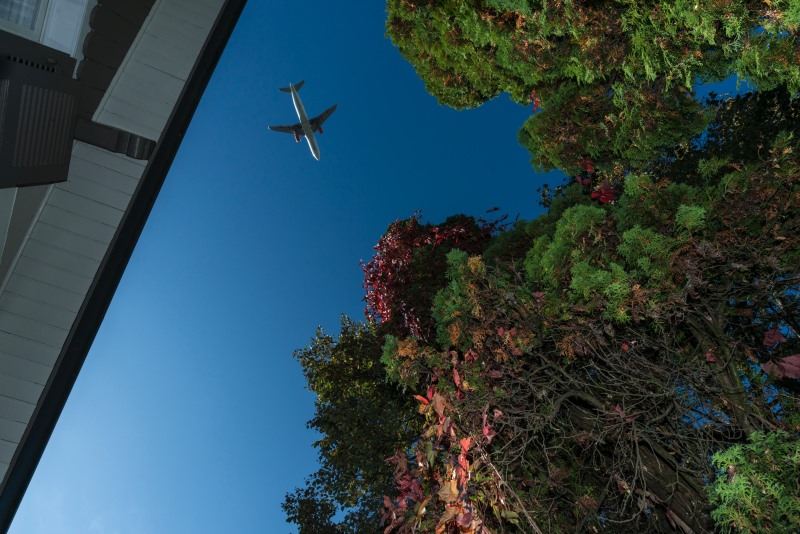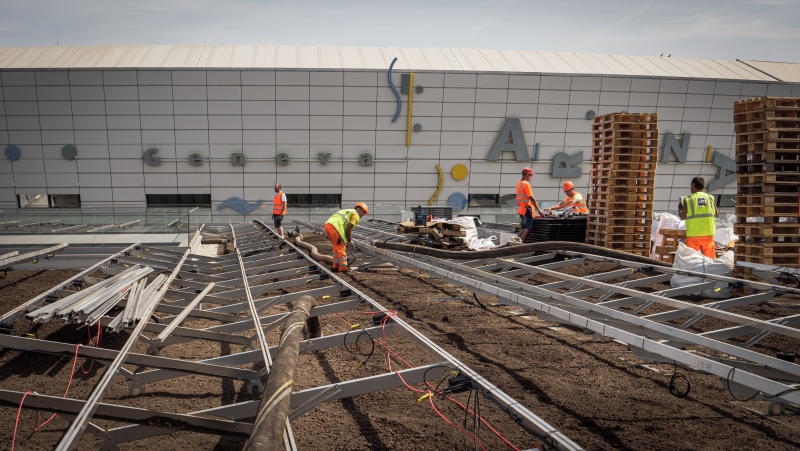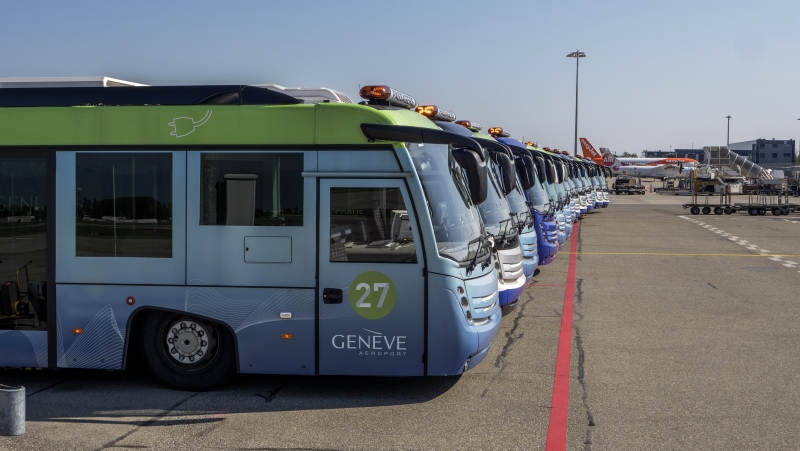 Go to Summary
Go to Summary

Progress towards more sustainable development
The mission of Genève Aéroport is to meet the demand for air connections from Switzerland as a national airport and meet the needs of the region on an ongoing basis. It has been pursuing a committed environmental policy for some years now. In July 2022 the company released its sustainable development report. This sets out how Genève Aéroport performed in 2021 against its sustainable development commitments.
New operating regulations
The year 2022 was marked by the approval by the Confederation of the new operating regulations for the airport. This document, also known as the «post- PSIA» dossier, deals in part with the implementation of the commitments made the Sectoral Plan for Aviation Infrastructure (PSIA), particularly with regard to noise abatement.
Specifically, the new operating regulations introduce an innovative system of quotas proposed by Genève Aéroport to limit take-offs scheduled before 10 pm but delayed beyond that time. The system specifies progressive penalties to act as a deterrent if the quotas are exceeded.
The regulations also specify a new limit on noise called “new permissible noise”, capping maximum noise from the airport. There will be a control system, and the airport has to propose action if limits are exceeded. The FOCA may also require action. Finally, this technical decision includes the adoption of a technical plan that will allow a new rapid runway exit to be built.
The airport’s new operating regulations were the subject of an appeal to the Federal Administrative Court by neighbouring municipalities and associations in January 2023. Implementation has been suspended pending the court’s decision.
At the same time Genève Aéroport continues to pursue the voluntary policy it has been following for some years now to limit the platform’s sound footprint. It has also set an ambitious objective: to cut its sound footprint to the level of the 2000s by 2030 *.
The airport has several approaches to achieve this. Here are two examples:
- Airlines are being encouraged to use the most modern (less noisy) aircraft by varying the landing fees charged to reflect the noise category.
- A special fee is also charged for taking off after 10 pm. Since the neighbours regard night flights as more sensitive, the impact of these is weighted ten times higher than daytime flights when calculating the noise contours.
* on the number of people impacted with the same population (2018).
Limiting the airport’s sound footprint
The sound footprint for 2022 has not yet been calculated. Between 2019 and 2021 the area of the zones exposed to noise fell by 18.1 km2.
2021 was an exceptional year, owing to the fall in air traffic. Logically, the noise impact associated with airport operations followed the same trend. Traffic at Geneva was up compared to 2020 (+14.9%), but is still well below the level seen before the pandemic (- 46.7% on 2019).
Soundproofing buildings in neighbouring municipalities
Because of its urban nature, Genève Aéroport operates a programme to soundproof homes in the municipalities nearby. More than 4,160 homes have been soundproofed since 2004, at a cost of CHF 58.7 million.
The programme has slowed considerably since the COVID-19 epidemic because of:
- Shortages of raw materials due to the geopolitical situation
- Fluctuations in the prices of these products
- Prolonged lead times for deliveries
- Difficulty in obtaining access to properties (lockdowns).
The recovery in contacts with building owners in spring 2022 was not enough to catch up with the backlog. The programme will be busier again in 2023.

GeniLac: work is under way
Work to connect the airport to the GeniLac green district heating network from SIG officially started on 29 November. This is a key project for the energy transition at the airport site. By 2026 the airport will be able to use lake water to cool and heat its buildings. The solid fuel system will be switched off, saving 2 million litres of fuel oil per year.
GeniLac will allow the airport to save 5,300 tonnes of CO2 emissions annually and cut them by 60%. CHF 37 million is being spent to adapt the infrastructure and install new equipment.
Genilac
Inauguration
A sub-station fitted with two heat pumps will be built to connect the airport to the GeniLac network. Genève Aéroport and SIG are working together to build a
3,800 m2 heating centre on the P45. On the one hand, it will house the GeniLac and, on the other, two SIG gas boilers connected to the to the cantonal district heating network, serving as a back-up in the event of extreme cold and as a back-up in the event of a breakdown.
While waiting for it to come on line in 2026, conversion work will be carried out on the existing freight buildings as far as the terminal. New buildings, like the East Wing, are designed to be connected directly to GeniLac.
The 3rd largest solar roof in the canton
A new large-scale solar installation came on stream on 13 October 2022 on the roof of the East Wing, the new building mainly serving long-haul flights. 6,700 m2 of photovoltaic panels are spread over the 520 m length of the building. The 3,773 modules will generate 1.5 GWh of electricity annually, enough to meet the consumption of the 40,000 m2 building.
The installation makes the East Wing the third-largest solar roof in the Canton of Geneva installed by SIG, after the Palexpo (15,000 m2) and the Aïre water treatment facility (7,200 m2). It also underscores what an exemplary building this is expected to be from an energy point of view, as it was designed to be a sustainable model.
Genève Aéroport is participating in the Swiss Confederation’s Exemplary Energy and Climate initiative and has given commitments between now and 2030:
- To save 25% of its energy use
- To increase its share of renewable energies to 70%
As part of this it signed a partnership with Services industriels de Genève (SIG) in 2017 to achieve a total surface area of 55,000 m2 of photovoltaic panels by 2030.
In 2021 the airport had 15,000 m2 of them. The area has increased significantly thanks to the East Wing and the installation of 1,500 m2 of panels on the new baggage sorting centre. Genève Aéroport had 22,800 m2 of panels in 2022 and now produces more than 3.8 GWh of solar electricity per year.
East Wing
Solar power plant (french)
Energy crisis: Genève Aéroport gets ready
There was an increased risk of electricity shortages in Switzerland in 2022. In November the airport put task force OSTRAL in place, named after the national organisation set up to ensure electricity supplies in the event of a crisis.
The task force consists of 15 or so people working in different parts of the company and met 12 times during the year. In collaboration with partners and suppliers it drew up a “shortage strategy” to anticipate energy shortages under four scenarios laid down by the Swiss Confederation. It also decided on preventive measures to save electricity which will be applied on an ongoing basis, such as:
- Lowering office temperatures to 20°C
- Using delayed heating
- Turning off sign lighting and publicity displays at night.
Raising energy efficiency
Also with an eye to saving energy and reducing its carbon footprint, Genève Aéroport completely renewed the lighting in its aircraft maintenance hangar in 2022. The 136 sodium lamps in the building were replaced by less energy-intensive LEDs over a three-month period.
All cleaning, inspection and repair work carried out on aircraft flying from Geneva are carried out in the main hangar. The works cost CHF 480,000 and will:
- Save 30% of the energy used
- Double the level of lighting
The new LEDs will bring Geneva up to standard and provide a level of lighting suitable for the airlines that use the space. Repairs will also be easier: the sodium lights were obsolete, making them especially difficult to repair or replace.
The system also includes a lighting management system connected to the platform’s weather station. This “intelligent lighting” makes it possible to use more of the daylight that comes through the glass doors installed on the building in 2016.
Energy efficiency
Removal of sodium lamps (french)
A green solar roof at the airport
In 2022, 6,000 m2 on the roof of the baggage sorting centre (BLC) currently being built were turned green. This was a major project costing CHF 187,000 and will be carried out in several stages between now and 2024. The aim is to promote biodiversity, reduce heat islands and limit the carbon footprint of the airport site.
In the first stage, carried out in 2022, 1,330 m2 of roof were turned green (seeding is planned for 2023). 930 m2 of solar panels producing 71 MWh of electricity were also installed, making it a biosolar roof. The plants lower the temperature of the panels and improve their yield. In return, the shade created by the solar installation encourage diversity of micro-habitats on the roof and a wider range of animal and plant species.

In a second stage a zone of 2,666 m2 between the East Wing and the GVA Center building was adapted. A cantonal subsidy of CHF 93,000 from the Nature in Town programme was granted for this space.
In 2024, the last roof of the BLC (1,945 m2), linking the main terminal to the GVA Center, will be greened. The total surface area of the airport site will then amount to approximately 10,800 m2 of green roofing.
Action on mobility
Genève Aéroport is putting measures in place to improve the quality of service and the passenger experience, especially accessibility on public transport. Since 2018 six morning Aérobus lines have served the platform free of charge from Geneva and neighbouring France. After the COVID-19 epidemic the offering was reduced (12 journeys instead of 20). At the same time the airport staff shuttle offering has been upgraded to meet the needs of employees.
A bike-sharing station available to all users and colleagues was installed on the departure level in 2021. The principle is simple: users can take any bike available and set off on it, with no need to bring it back. The offer was maintained in 2022 and will be enhanced in 2023 by adding a further three or four stations.
A survey looking at employee mobility across the whole airport platform was conducted in 2022. A total of 1,555 people took part. The results show that 39% of employees use a sustainable means of transport to get to work at the airport. This is almost exactly the same level as in 2017. The target of reaching 45% in 2020 was therefore not met. Looking only at employees of Genève Aéroport takes the figure to 46%. Publicity campaigns highlighting the advantages offered to employees of partner companies on the platform in terms of soft mobility will be run in 2023.
Electrifying the buses on the tarmac
The airport intends to decarbonise 90% of the vehicle fleet by 2030. In 2016 it therefore committed to buy ten new electric buses for transporting passengers over five years, representing a total investment of CHF 6.5 million. Having fallen behind schedule because of the COVID-19 epidemic, the last two buses under the programme arrived on site in April 2022. Now 14 of the 30 buses run on electricity, 46% of the fleet. They save around 50 tonnes of CO2 per year.
In order to continue its transition to electric mobility, Genève Aéroport will, from 2023 onwards, modify 10 buses in its fleet over 5 years (retrofit buses). This technology consists of replacing diesel engines with electric ones while retaining the structure of the vehicle. It also has the advantage of being less expensive: a retrofitted bus costs less than half the price of a brand- new electric one.

Reducing waste on the platform
Genève Aéroport is looking to reduce the quantity of waste on the airport site. All security and surveillance teams were trained in sorting waste this year. They also had the opportunity to submit their suggestions. These will be studied for feasibility in 2023.
ACA3+ certification renewed
The ACA3+ certification issued by the Airports Council International (ACI) was renewed in 2022. This certifies that the airport infrastructure is carbon-neutral and is further proof of the company’s commitment to the environment and sustainable development.
In the coming years Genève Aéroport is aiming to achieve a higher level: ACA 4 or ACA 4+.
These are the degrees of certification:
ACA 3+ indicates carbon neutrality by compensating residual emissions, while ACA 4 shows airport and partner operations have been optimised to achieve absolute reductions in emissions. The ACA 4+ certification attests to the compensation of emissions.
Raising awareness of light pollution
On 23 September Genève Aéroport took part in the “The night is beautiful” event. The aim of this was to raise general awareness of light pollution. As in 2021, all lights on the airport platform were put out for the whole night once traffic had stopped. This covered the runway and the satellites. Only the lighting masts on the tarmac were left on. Nighttime working was suspended.
The illuminated signs on the roof of the main building, Terminal 2, Freight and the GVA Center were also turned off.

